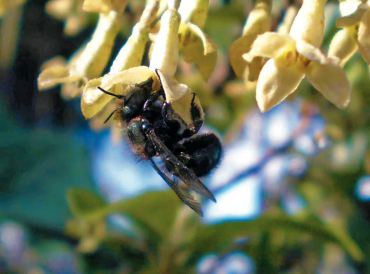
The orchard mason bee, or blue orchard bee, is the western native pollinator that appears each year in late winter and early spring to pollinate all the early blooming fruit trees and flowers. Its scientific name, Osmia Lignaria Propinqua Cresson, describes the insect order to which it belongs that also includes ants, bees and wasps.
The orchard mason bee is native to North America and has an Eastern United States cousin.
The all-black bee is easy to spot in late winter and early spring as it buzzes around, looking for nesting holes at your house and for nectar-producing flowers to feast upon. One of my favorite plants, Pieris Japonica (shrub), is among the earliest bloomers that the hungry mason bee will find. It blooms well into spring, helping the bees survive a colder than normal year.
With many of the other native and honeybee populations in trouble due to a mite called Krombeini Baker, it is even more important to provide proper shelter for the mason bee. Why harvest and provide housing for these fascinating bees? Simply put, they are the best pollinators in the world of bees. They will pollinate effectively 1,600 flowers per day, whereas a European honeybee will visit 600 to 700 flowers per day, but only pollinate 30 of them (a dismal 5 percent success rate).
The mason bee cycle begins when temperatures outside reach 50-55 degrees in late winter or early spring, which encourages the male bees to emerge from their cocoons. They operate for a few weeks building up their strength and then the females emerge.
A brief mating ritual occurs and her work begins. She will move from tree to tree, shrub to shrub, thus actively cross-pollinating the fruit. Her first effort is to gather some mud to pack into her first nesting chamber as a support wall. She then makes 15 to 20 trips gathering nectar and pollen, which she packs against the mud wall.
She enters the cavity and lays her first egg, pushing it into the nectar and pollen mass, and then gathers more mud to close off the first chamber. This continues as she lays 32-36 eggs in her life cycle.
Most fascinating is that she will determine the sex of the egg, laying female eggs deeper in the protected holes and male eggs out front. When she is impregnated, she has a sperm sack in her body and only releases sperm to her eggs when she knows it will be safe. When sperm is released from her sack, she has created a female egg.
The deeper the hole, the more female eggs are produced, so I recommend using the 6-inch-hole cardboard straw system with a white paper straw inside the protective cardboard tube for your housing. The beauty of the cardboard with liner is you can change the liner out each year, thus eliminating any predators that may be residing in your mason bee homes. After years of study, it was determined the 5/16th-inch is preferred by the mason bee. A word of caution: Do not use the old wood block method of providing housing for your backyard mason bees. Brian Griffin of Bellingham, the author of “The Orchard Mason Bee,” found the Krombeini mites in his wood blocks about 10 years ago and realized they were clinking and adhering to the wood of the block. He designed the new cardboard and paper liner system used today.
Make sure that your cardboard tubes are thick enough to ward off the driller wasp, which can enter the chambers and drill a hole in the thin tubes on the market now, laying its egg perfectly inside the cocoon of the mason bee.
Be careful, as well, in finding cocoons sold in little boxes, sorted, washed, bleached and, in my opinion, handled too much, disturbing their natural emerging process.
Always place your mason bee homes in a sunny, southerly location, so that they will get sun all day. Have a little rain cover over the straws, just so that the cover won’t block any sun but will stop some of the spring rains. Don’t make the mistake of putting your straw systems on the fruit trees: As the fruit trees leaf out, they will block the sun and your bees will not get the appropriate 50-55 degree temperatures to be active.
This nonaggressive, solitary bee is considered a nonstinger. Even though the female has a stinger, it’s nonlethal for those who may be highly allergic to bee stings. Their only interest is in food and egg production and they are fascinating to watch as they bump into you while you observe their activity.























Comments